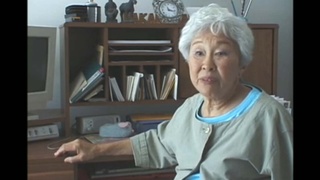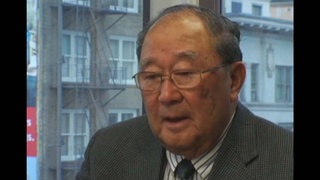Interviews
Government's permission to publish Japanese newspaper in Canada during World War II
And in fact, incidentally, Tom Shoyama, just about that time, the newspaper they had, he had was The New Canadian. And The New Canadian was immediately, in December, right after the war, soon after, was shut down. But then they came to them and they said they want some information, they want the Japanese people to know. "You have a running newspaper, can you inform Japanese people that they have to register?" So that's in January, they said they have to go and register. Well, he says, "I can't unless I, unless I have a newspaper to send out." And then he said, "Not only that, I have to have, be able to write" -- see, they didn't like the idea of him writing a newspaper that had English and Japanese in it, because Japanese was foreign to them, and they said this was code. "You could, you could tell people to do things without knowledge of, of the authorities." "Well," he says, "I can't write a, unless you give me information, I can't write a, just a blanket statement saying you have to register, you have to give 'em a reason why this was being done." It's a part of the, part of the, as a matter of fact, they were using the War Measures Act to do this. Anyhow, they said, "Okay, we'll give you, we'll give you the, the permission to go back and produce your newspaper." So they allowed him to put the newspaper back out.
Date: July 25 & 26, 2006
Location: Washington, US
Interviewer: Tom Ikeda
Contributed by: Denshō: The Japanese American Legacy Project.
Explore More Videos

Importance of education in achieving redress for incarceration
(1919-2014) Activist for civil rights and redress for World War II incarceration of Japanese Americans.

Her experience as a Japanese-American schoolchild in Oceanside, California, after the bombing of Pearl Harbor
(1924-2018) Artist and playwright.

Loss of happy-go-lucky adolescence in Puyallup Assembly Center
(b. 1923) Nisei from Washington. Resisted draft during WWII.

Memories of dusty conditions at Minidoka incarceration camp
(b. 1923) Nisei from Washington. Resisted draft during WWII.

Making the decision to resist the draft
(b. 1923) Nisei from Washington. Resisted draft during WWII.

The impact of Pearl Harbor on his family
(b. 1918) Issei businessman in Canada

Discharged from the U.S. Army after Pearl Harbor
(b. 1918) Founder Azumano Travel

Reaction to a 1942 speech by Mike Masaoka, Japanese American Citizen League's National Secretary
(1915 - 2011) Nisei florist who resettled in New York City after WW II. Active in Japanese American civil rights movement

Death of sister in October 1942
(1915 - 2011) Nisei florist who resettled in New York City after WW II. Active in Japanese American civil rights movement

First impression of New York City during war time
(1915 - 2011) Nisei florist who resettled in New York City after WW II. Active in Japanese American civil rights movement

Neighbors' sympathy after Pearl Harbor
(1915 - 2011) Nisei florist who resettled in New York City after WW II. Active in Japanese American civil rights movement

Reaction of Japanese American community toward draft resistance stance
(b. 1925) Draft resister

The role of the media in influencing people's opinions
(b. 1925) Draft resister

Living conditions in prison while serving time for resisting the draft
(b. 1925) Draft resister

Talking to children about decision to resist the draft during World War II
(b. 1925) Draft resister
